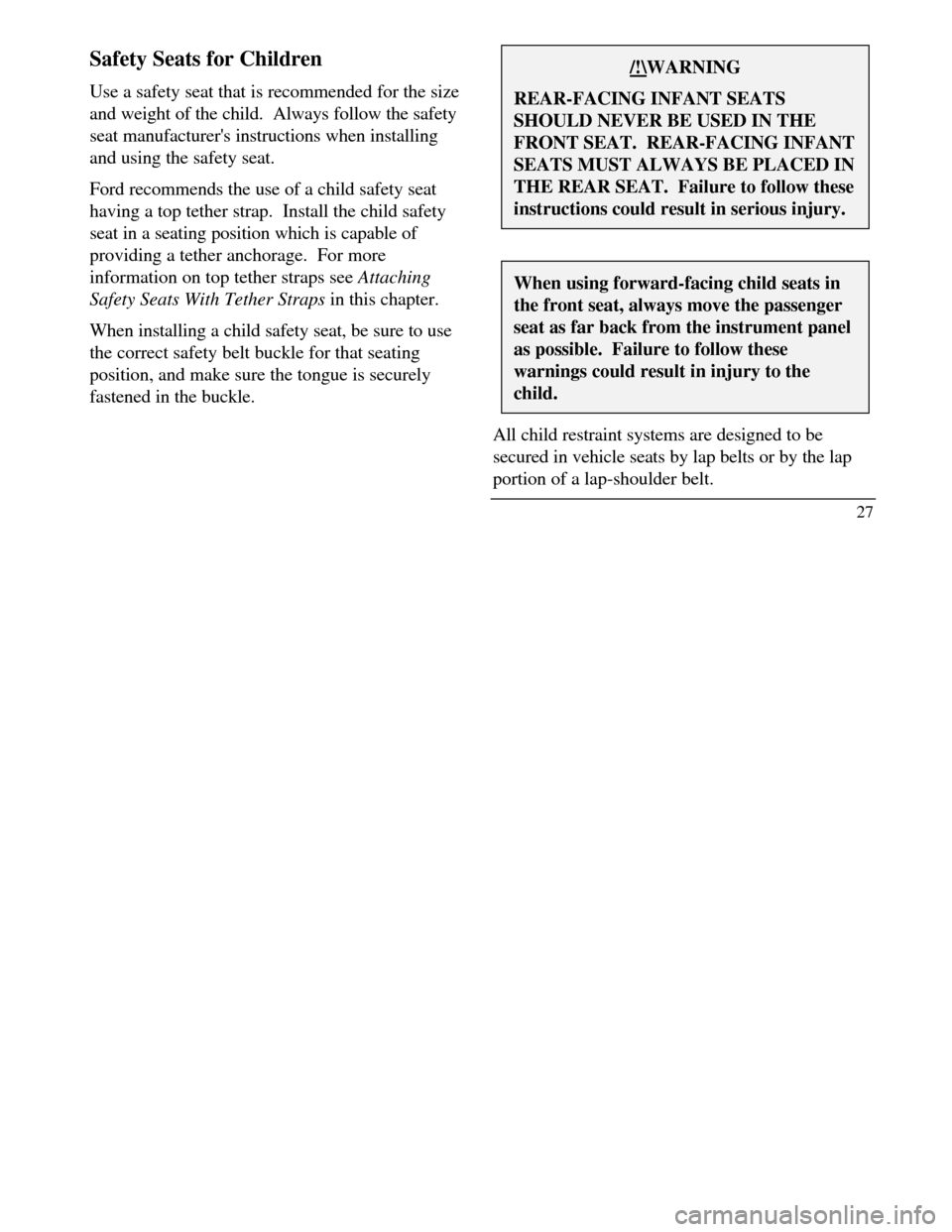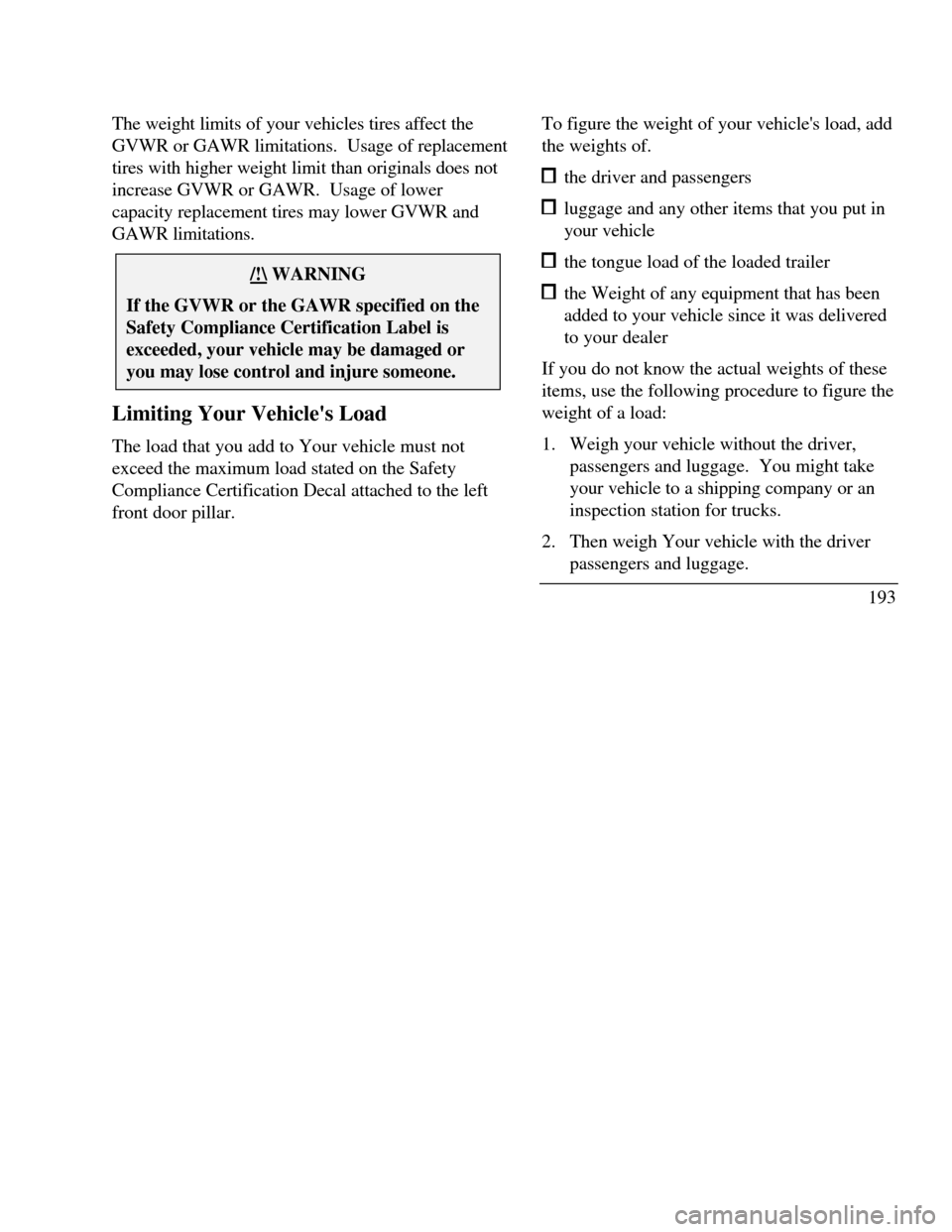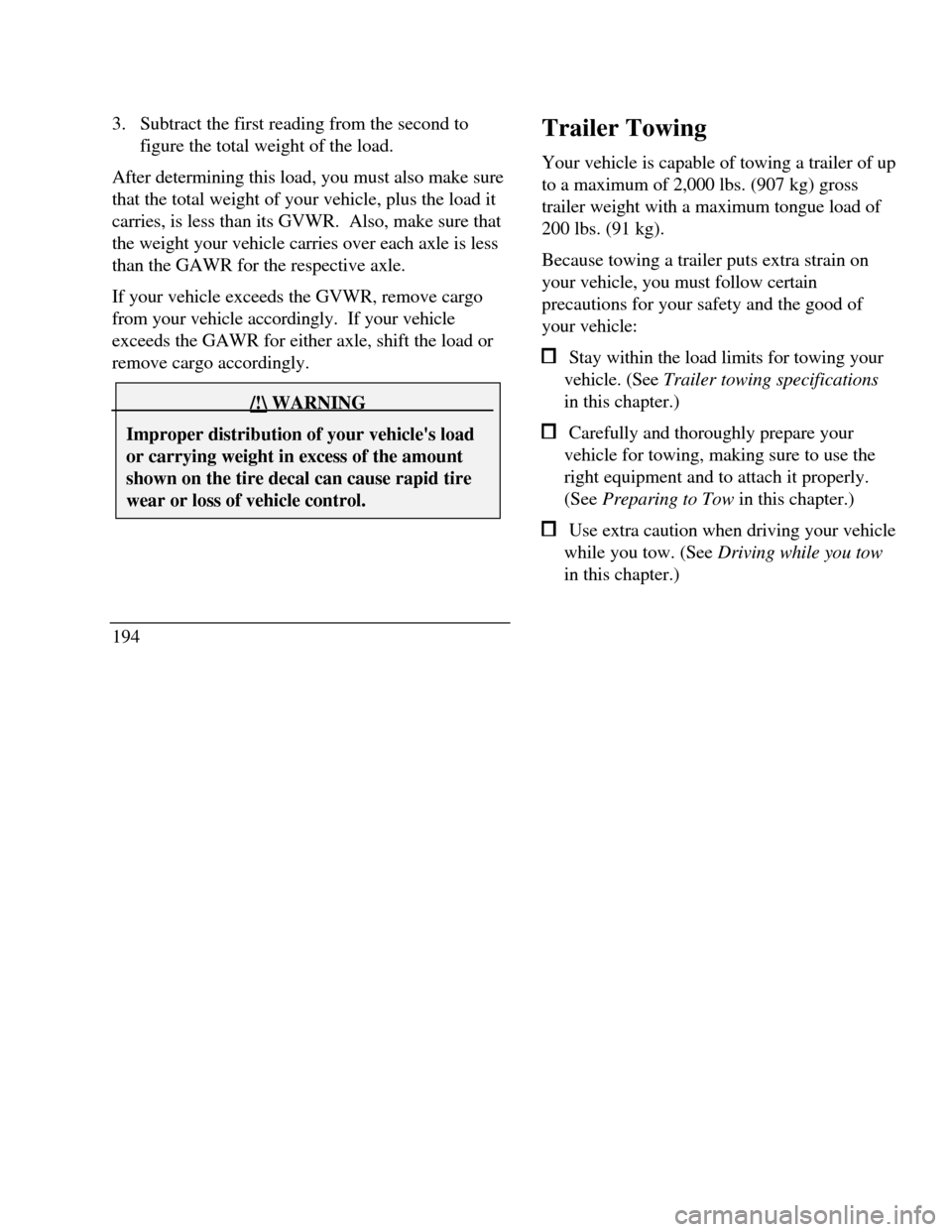Page 26 of 320
If a collision occurs, the sensors sense the
severity of the impact and activates the air bags
if necessary. The air bag system is designed to
deploy in frontal and front-angled collisions
more severe than hitting a parked vehicle (of
similar size and weight) head-on at about 28
mph (45 km/h). Because the system senses the
crash severity rather than vehicle speed, some
frontal collisions at speeds above 28 mph (45
km/h) will not inflate the air bag.
22When the sensors activate the system, the air bags
inflate rapidly, filling with non-toxic nitrogen gas in
a fraction of a second. Immediately after inflation,
the air bags deflate by releasing the nitrogen gas
through vent holes. The whole process takes place
in a matter of seconds./!\ WARNINGAir bag system components get hot afterinflation. Do not touch them after inflation.
Page 31 of 320

Safety Seats for Children
Use a safety seat that is recommended for the size
and weight of the child. Always follow the safety
seat manufacturer's instructions when installing
and using the safety seat.
Ford recommends the use of a child safety seat
having a top tether strap. Install the child safety
seat in a seating position which is capable of
providing a tether anchorage. For more
information on top tether straps see Attaching
Safety Seats With Tether Straps in this chapter.
When installing a child safety seat, be sure to use
the correct safety belt buckle for that seating
position, and make sure the tongue is securely
fastened in the buckle./!\WARNINGREAR-FACING INFANT SEATSSHOULD NEVER BE USED IN THEFRONT SEAT. REAR-FACING INFANTSEATS MUST ALWAYS BE PLACED INTHE REAR SEAT. Failure to follow theseinstructions could result in serious injury.When using forward-facing child seats inthe front seat, always move the passengerseat as far back from the instrument panelas possible. Failure to follow thesewarnings could result in injury to thechild.All child restraint systems are designed to be
secured in vehicle seats by lap belts or by the lap
portion of a lap-shoulder belt.
27
Page 195 of 320

/!\ WARNINGDo not spin the wheels at over 35 mph (55km/h). The tires may fail and injure apassenger or bystander.By moving the vehicle backward and forward, you
may gain enough momentum to move out of the
spot. Do not rock the vehicle for more than a few
minutes. This may overheat the engine, damage the
transaxle, or damage the tires. If you are still stuck
after a minute or two of rocking, call for a tow truck.
High water
Do not drive through flooded areas unless you are
sure that the water is below the bottom of the wheel
rims.
If you must drive through high water, drive slowly.
You may have limited traction or wet brakes, so
allow extra stopping distance because your vehicle
will not stop as quickly as usual.
192After you drive through the standing water,
apply your brakes gently several times as your
vehicle moves slowly. This helps to dry the
brakes.
Driving With a Heavy Load
There are limits to the amount of weight your
vehicle can carry or tow. The total weight of
your vehicle, plus the weight of the passengers
and cargo, should never be more than the
Gross Vehicle Weight Rating (GVWR). Also,
the weight that your vehicle carries over the
front axle and rear axle should never be more
than the Gross Axle Weight Rating (GAWR)
for the respective axle.
You can find your vehicle's GVWR and
GAWR on the Safety Compliance Certification
Label on the left front door lock facing or on
the door latch post pillar.
Page 196 of 320

The weight limits of your vehicles tires affect the
GVWR or GAWR limitations. Usage of replacement
tires with higher weight limit than originals does not
increase GVWR or GAWR. Usage of lower
capacity replacement tires may lower GVWR and
GAWR limitations./!\ WARNINGIf the GVWR or the GAWR specified on theSafety Compliance Certification Label isexceeded, your vehicle may be damaged oryou may lose control and injure someone.Limiting Your Vehicle's Load
The load that you add to Your vehicle must not
exceed the maximum load stated on the Safety
Compliance Certification Decal attached to the left
front door pillar.To figure the weight of your vehicle's load, add
the weights of. the driver and passengers luggage and any other items that you put in
your vehicle the tongue load of the loaded trailer the Weight of any equipment that has been
added to your vehicle since it was delivered
to your dealer
If you do not know the actual weights of these
items, use the following procedure to figure the
weight of a load:
1. Weigh your vehicle without the driver,
passengers and luggage. You might take
your vehicle to a shipping company or an
inspection station for trucks.
2. Then weigh Your vehicle with the driver
passengers and luggage.
193
Page 197 of 320

3. Subtract the first reading from the second to
figure the total weight of the load.
After determining this load, you must also make sure
that the total weight of your vehicle, plus the load it
carries, is less than its GVWR. Also, make sure that
the weight your vehicle carries over each axle is less
than the GAWR for the respective axle.
If your vehicle exceeds the GVWR, remove cargo
from your vehicle accordingly. If your vehicle
exceeds the GAWR for either axle, shift the load or
remove cargo accordingly./!\ WARNINGImproper distribution of your vehicle's loador carrying weight in excess of the amountshown on the tire decal can cause rapid tirewear or loss of vehicle control.194Trailer Towing
Your vehicle is capable of towing a trailer of up
to a maximum of 2,000 lbs. (907 kg) gross
trailer weight with a maximum tongue load of
200 lbs. (91 kg).
Because towing a trailer puts extra strain on
your vehicle, you must follow certain
precautions for your safety and the good of
your vehicle: Stay within the load limits for towing your
vehicle. (See Trailer towing specifications
in this chapter.) Carefully and thoroughly prepare your
vehicle for towing, making sure to use the
right equipment and to attach it properly.
(See Preparing to Tow in this chapter.) Use extra caution when driving your vehicle
while you tow. (See Driving while you tow
in this chapter.)
Page 198 of 320
Service your vehicle more frequently if you tow a
trailer. (See Servicing your vehicle if you tow in
this chapter.)
Ten to 15% of the loaded trailer's weight should be
on the tongue. However, the tongue load should
never exceed 10% of the maximum weight that your
vehicle can safely tow.
New vehicles should be driven 2,000 miles (3,200
km) before towing a trailer./!\ WARNINGTowing trailers beyond the maximumrecommended gross trailer weight exceeds thelimit of the vehicle and could result in enginedamage, transaxle damage, structuraldamage, loss of control, and personal injury./!\ WARNINGDo not tow a trailer when thetemporary spare tire is being used.See the following chart for the amount of
weight your vehicle can tow.
195
Page 199 of 320

Towing ClassLight-dutyMaximum gross trailer
weight1,000/2,000 lbs. (454/907
kg)*Maximum tongue load100/200 lbs. (45/91 kg)Engine4.OLHitch designLoad carrying typeTraffer-tow package
optionNot requiredVehicle speed should not exceed 45 mph (72 km/h) when
towing on grades. Limit maximum gross trailer weight to
1,000 lbs. (454 kg) and maximum tongue load to 100 lbs. (45
kg): (1) when you are towing a trailer on steep hills or on
moderate hills for a long distance (five miles (8 kms) or more)
(2) on very hot days (when the temperature is 1OO°F (38°C)
or more).
You should also limit your trailer's load when you
tow in high altitudes.
196Preparing to Tow
For your safety and for the good of your
vehicle, use the right equipment for the type of
trailer you tow. Also, make sure that all
towing equipment is properly attached to your
vehicle. If you are not certain that you are
using the right equipment in the proper manner,
see your Ford or Lincoln-Mercury dealer.
Do not use hitches that clamp onto your
vehicle's bumper. The bumper is not designed
to bear the load.
Always check the pressure in all your vehicle's
tires when preparing to tow (see inflation
recommendation on the tire label).
Connecting the safety chains
Always attach the trailer's safety chains to your
vehicle. They help protect your trailer if the
hitch breaks.
Page 200 of 320

To connect the trailer's safety chains:
1. Cross the chains under the trailer tongue and
attach them to your vehicle's frame or hook
retainers. Never attach the safety chains to your
vehicle's bumper. The bumper is not designed to
bear the weight of a trailer.
2. Make sure that you leave enough slack in the
chains to allow you to turn corners.
If you use a rental trailer, follow the instructions that
the rental agency gives you.
Connecting the trailer's brakes
Electric brakes and manual, automatic, or surge-type
hydraulic brakes are safe if you install them properly
and adjust them according to the manufacturer's
instructions. Be sure that your trailer's brakes meet
local and federal regulations.
Separate trailer brakes of adequate size should be
used for trailers weighing over 1.000 lbs. (454 kg)
loaded weight./!\ WARNINGDo not connect a trailer's hydraulicbrake system directly to your vehicle'sbrake system. Your vehicle may nothave enough braking power and yourchances of having a collision greatlyincrease.Connecting the trailer's lights
Do not connect a trailer's fighting system
wiring directly to your vehicle's fighting
system wiring. To get the proper equipment
for hooking up your trailer's lights, see your
local trailer dealer and your Ford dealer. Be
sure to follow their instructions carefully.
If you do not install trailer lights correctly, you
may cause damage to the vehicle's hghting
system.
197